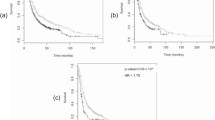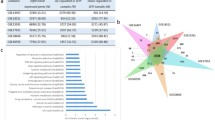Summary
The purpose of this study was to pool information in epithelial ovarian cancer by combining studies using Affymetrix expression microarray datasets made at different laboratories to identify novel biomarkers. Epithelial microarray expression information across laboratories was screened and combined after preprocessing raw microarray data, then ANOVA and unpaired T test statistical analysis was performed for identifying differentially expressed genes (DEGs), followed by clustering and pathway analysis for these DEGs. In this work, we performed a combination analysis on microarrays from three different laboratories using gene expression data on ovarian cancer and obtained a list of differential expression profiles identified as potential candidate in aggressiveness of ovarian cancer. The clustering and pathway analysis explored the different molecular basis of different ovarian cancer stages and potential important regulatory pathways in ovarian cancer development. Our results showed that combination of microarray data from different laboratories in the same platforms may overcome biases derived from probe design and technical features, thereby accelerating the identification of trustworthy DEGs, and demonstrating the advantage of integrative analysis in gene expression studies on epithelial ovarian cancer research.
Similar content being viewed by others
References
Gu MJ, Shi W. Current research and management of ovarian cancer in China. Chinese-German J Clin Oncol, 2002, 1(4):212–218
Rosen DG, Wang L, Atkinson JN, et al. Potential markers that complement expression of CA125 in epithelial ovarian cancer. Gynecol Oncol, 2005, 99(2): 267–277
Chuaqui RF, Cole KA, Emmert-Buck MR, et al. Histopathology and molecular biology of ovarian epithelial tumors. Ann Diagn Pathol, 1998, 2(3):195–207
Niloff JM, Klug TL, Zurawski VR Jr, et al. Elevation of serum CA125 in carcinomas of the fallopian tube, endometrium, and endocervix. Am J Obstet Gynecol, 1984, 148(8):1057–1058
Meyer T, Rustin GJ. Role of tumor markers in monitoring epithelial ovarian cancer. Br J Cancer, 2000, 2(9):1535–1538
Welsh JB, Zarrinkar PP, Sapinoso LM, et al. Analysis of gene expression profiles in normal and neoplastic ovarian tissue samples identifies candidate molecular markers of epithelial ovarian cancer. Proc Natl Acad Sci U S A, 2001, 98(3):1176–1181
Santin AD, Zhan F, Bellone S, et al. Gene expression profiles in primary ovarian serous papillary tumors and normal ovarian epithelium: identification of candidate molecular markers for ovarian cancer diagnosis and therapy. Int J Cancer, 2004, 112(1):14–25
Skubitz APN, Pambuccian SE, Argenta AP, et al. Differential gene expression identifies subgroups of ovarian carcinoma. Transl Res, 2006, 148(5):223–248
Xu L, Tan AC, Winslow RL, et al. Merging microarray data from separate breast cancer studies provides a robust prognostic test. BMC Bioinformatics, 2008, 27,9:125
Edgar R, Domrachev M, Lash AE. Gene expression omnibus: NCBI gene expression and hybridization array data repository. Nucleic Acids Res, 2002, 30(1):207–210
Pejovic T, Yates JE, Liu HY, et al. Cytogenetic instability in ovarian epithelial cells from women at risk of ovarian cancer. Cancer Res, 2006, 66(18):9017–9025
Eisen MB, Spellman PT, Brown PO, et al. Cluster analysis and display of genome-wide expression patterns. Proc Natl Acad Sci U S A, 1998, 95(25):14 863–14 868
Dennis G Jr, Sherman BT, Hosack DA, et al. DAVID: Database for annotation, visualization, and integrated discovery. Genome Biol, 2003, 4(5):3
Huang DW, Sherman BT, Lempicki RA. Systematic and integrative analysis of large gene lists using DAVID bioinformatics resources. Nature Protoc, 2009, 4(1):44–57
Bellone S, Siegel ER. Overexpression of epithelial cell adhesion molecule in primary, metastatic, and recurrent/chemotherapy-resistant epithelial ovarian cancer: implications for epithelial cell adhesion molecule-specific immunotherapy. Int J Gynecol Cancer, 2009, 19(5):860–866
Wei L, Xue T. Roles of clusterin in progression, chemoresistance and metastasis of human ovarian cancer. Int J Cancer, 2009, 125(4):791–806
Rump A, Morikawa Y. Binding of ovarian cancer antigen CA125/MUC16 to mesothelin mediates cell adhesion. J Biol Chem, 2004, 279(10):9190–9198
Ross PL, Cheng I, Liu X, et al. Carboxypeptidase 4 gene variants and early-onset intermediate-to-high risk prostate cancer. BMC Cancer, 2009, 9:69
Fukumoto M, Nakayama K. Ovarian epithelial tumors of low malignant potential: are they precursors of ovarian carcinoma? Pathol Int, 2006, 56(5):233–239
Farley J, Ozbun LL, Birrer MJ. Genomic analysis of epithelial ovarian cancer. Cell Res, 2008, 18(5):538–548
Tseng GC, Cheng C, Yu YP, et al. Investigating multi-cancer biomarkers and their cross-predictability in the expression profiles of multiple cancer types. Biomark Insights, 2009, 4:57–79
Misra UK, Deedwania R, Pizzo SV. Binding of activated alpha2-macroglobulin to its cell surface receptor GRP78 in 1-LN prostate cancer cells regulates PAK-2-dependent activation of LIMK. J Biol Chem, 2005, 280(28):26 278–26 286
Zbroja-Sontag W. Defense proteins and immune complexes in the blood serum of women with inflammatory and neoplastic lesions of the ovary. Am J Reprod Immunol, 1983, 4(1):11–20
Kurer MA. Protein and mRNA expression of tissue factor pathway inhibitor-1 (TFPI-1) in breast, pancreatic and colorectal cancer cells. Mol Biol Rep, 2007, 34(4):221–224
Author information
Authors and Affiliations
Corresponding author
Additional information
These authors contributed equally to this work.
This project was supported by grants from the National Science Foundation of China (No. 30801340; No.30901586; No.30770913).
Rights and permissions
About this article
Cite this article
Jiang, X., Zhu, T., Yang, J. et al. Identification of novel epithelial ovarian cancer biomarkers by cross-laboratory microarray analysis. J. Huazhong Univ. Sci. Technol. [Med. Sci.] 30, 354–359 (2010). https://doi.org/10.1007/s11596-010-0356-1
Received:
Published:
Issue Date:
DOI: https://doi.org/10.1007/s11596-010-0356-1




